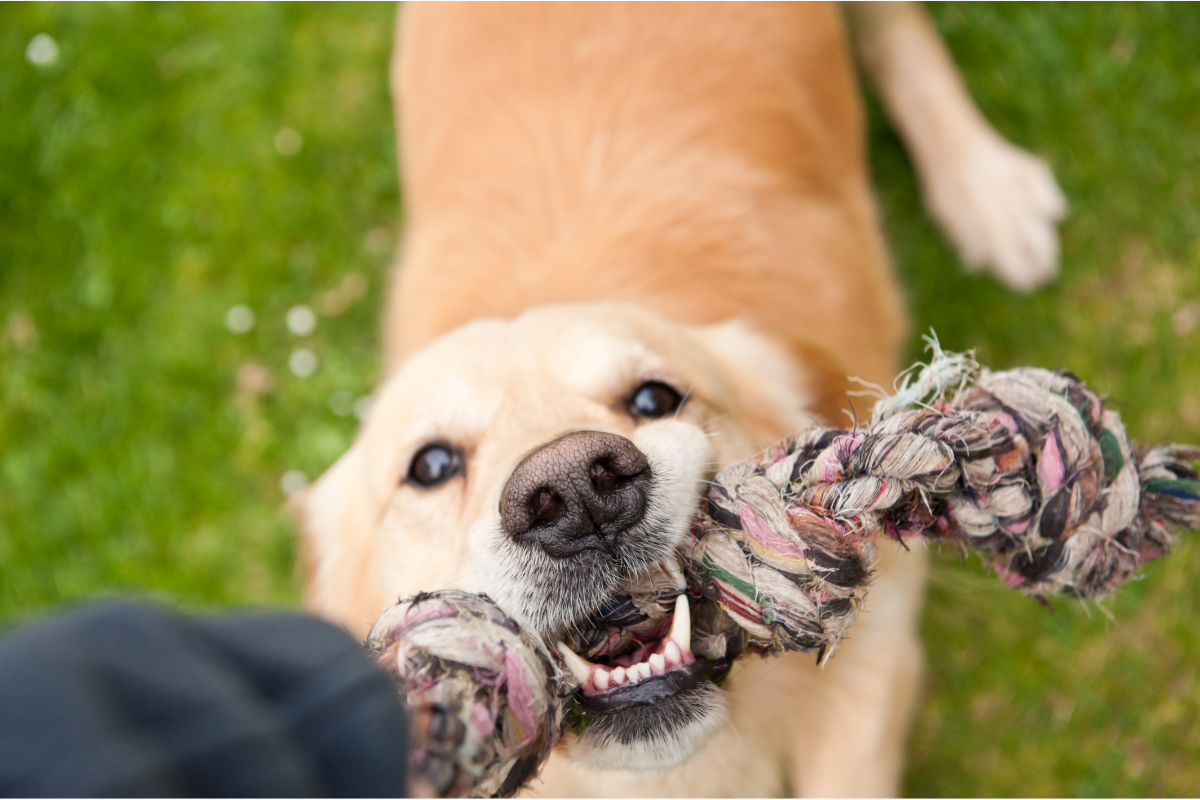Dog biting is a major challenge for owners and animal behaviour professionals. Understanding the reasons behind this behaviour is essential to prevent incidents and ensure everyone’s safety. Bites can be the result of a variety of factors, from anxiety and fear to socialisation and hierarchy issues. This article explores the root causes of dog biting, the warning signs to look out for, and strategies for managing and correcting this problematic behaviour. By adopting an informed and proactive approach, it is possible to reduce the risk of bites and promote harmonious cohabitation between dogs and humans.
What is a bite in dog behaviour?
According to the Larousse dictionary, a bite is a “wound caused by the teeth of an animal”, involving an invasion of the skin. Dehasse J. (2002) defines aggression as behaviour aimed at damaging the physical integrity or freedom of another individual. Thus, warning signals such as growling or curling the lips are aggressions to be taken seriously.
Aggressive behaviour in dogs responds to stimuli and varies according to genetics,environment and training. Aggression follows a sequence:
- Warning phase: auditory signals (growling) and visual signals (posture, pilo-erection).
- Consumption phase: the attack, with a more or less controlled bite.
- Appeasement phase: licking, escape, return to equilibrium.
Aggressions can be classified as :
- Competition for resources: monopolising food or space.
- Territorial and maternal: protection of space or young.
- Irritation: reaction to an irritating stimulus.
- Fear: absence of intimidation phase, multiple bites.
- Predation: aggression towards targets perceived as prey.
Bites can become instrumental, i.e. the dog simplifies the aggression sequence by going straight to the bite, making the behaviour less predictable and more intense. Predation and aggression should not be confused, as predation aims to kill a resource, whereas aggression aims to put a protagonist at a distance.
Why did the dog bite?
Statistics on dog bites
The average age of biting dogs varies according to the studies. Chomel B. (20) found that the majority of biting dogs were young (under 15 months), while Ricard C. observed that 68% were adult dogs (15 months to 7 years). Another study revealed that 94% of biting dogs were between 1 and 5 years old. The lifespan of dogs varies according to breed, influencing bite data. Serious bites are often caused by large dogs, which have a shorter life expectancy. Many biting dogs are euthanised (34%) or kept away from children (19%).
Males bite more often than females (74% of bites according to a 2010 survey), even though only 47.2% of pedigree dogs are male. Unneutered males are more likely to bite than unneutered females. Whole dogs are often responsible for bites, especially males.
In terms of breed , German shepherds are frequently implicated, but these data must be interpreted with caution to avoid stigmatisation. In the United States, pit bulls and cross-breeds are often mentioned, although the breed is sometimes unknown.
The size and weight of dogs influence the severity of bites. Dogs weighing more than 25 kg cause more serious injuries. Most bites are inflicted by dogs known to the victim, often the family dog. Behavioural disorders and health problems can increase dog aggression. Recidivism varies from study to study: some dogs have never bitten before, while others have bitten before.
Who are the main victims of dog bites?
A study by the European Home and Leisure Accidents Surveillance System (EHLASS) reports 500,000 bites a year in France, 60,000 of which require hospital treatment. However, there are no official statistics on the number of bites. The figures, based solely on medical consultations, indicate a few thousand bites a year, but are probably underestimated.
In Spain, a study (1995-2004) showed an annual incidence of dog bites of 12.8 per 100,000 inhabitants in densely populated areas, compared with 71.3 per 100,000 in sparsely populated areas. In Belgium, a telephone survey revealed an annual incidence of 2. 2% among children. Less than half of these bites are reported to an authority.
At Trousseau Hospital, out of 237 bite cases (1991-1994), 35. 7% of bitten children were under 5 years old. Between May and June 2010, out of 485 bite victims in eight French hospitals, 36% were children under the age of 15.
In Italy, a study of 1,160 patients identified the 20-29 age group as the most affected. In the United States, 31% of 111 dogs biting children were under 6 years old. In Spain, children under 15 are three times more likely to be bitten than adults.
French studies show no significant correlation between the sex of the victim and the likelihood of being bitten, although boys are bitten slightly more often than girls. In Italy and Spain, men are generally more at risk than women.
What does the law say about dogs that bite?
The French Rural and Maritime Fishing Code and the Ministerial Order of 21 April 1997 govern the monitoring of biting animals to assess their behaviour and check that there is no risk of rabies. Owners must report any bites to their local town hall. The bitten animal must be monitored by a vet for 15 days, with compulsory visits every 1, 7 and 15 days. In the event of death or euthanasia, the animal’s head is sent to the Institut Pasteur for rabies diagnosis.
A behavioural assessment by a qualified vet is required, and the report is sent to the mayor, who may require the owner to undergo training. Under article 1243 of the French Civil Code, owners are liable for any damage caused by their pets. In the event of serious danger, the mayor may order the animal to be euthanised following veterinary advice.
During surveillance, the animal cannot be vaccinated against rabies. If no signs of rabies are detected, a final certificate is issued, one copy of which is given to the town hall and another to the person bitten.





